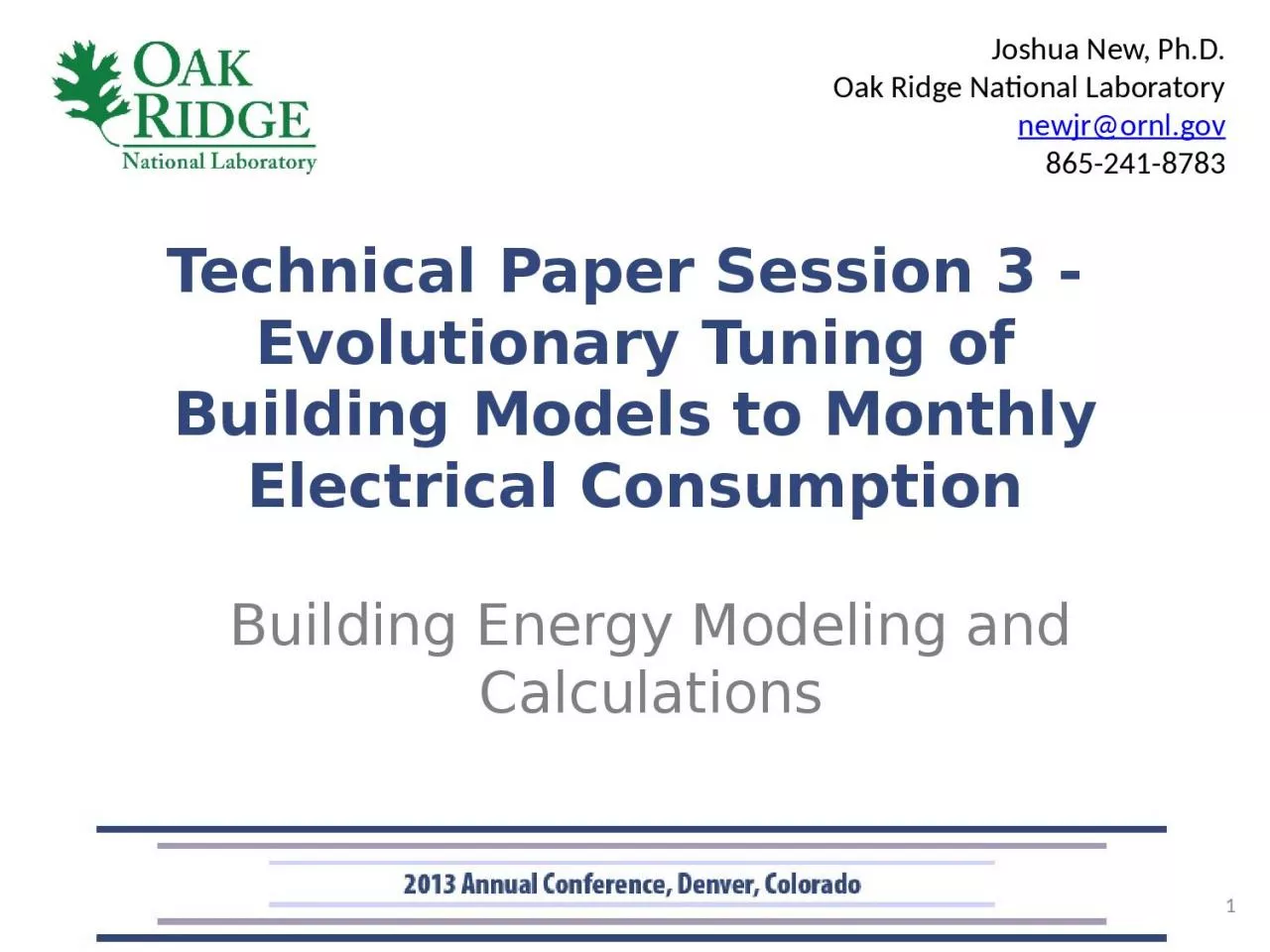

Evolutionary Tuning of Building Models to Monthly Electrical Consumption Building Energy Modeling and Calculations Joshua New PhD Oak Ridge National Laboratory newjrornlgov 8652418783 1 ID: 1021024
Download Presentation The PPT/PDF document "Technical Paper Session 3 -" is the property of its rightful owner. Permission is granted to download and print the materials on this web site for personal, non-commercial use only, and to display it on your personal computer provided you do not modify the materials and that you retain all copyright notices contained in the materials. By downloading content from our website, you accept the terms of this agreement.
1. Technical Paper Session 3 - Evolutionary Tuning of Building Models to Monthly Electrical ConsumptionBuilding Energy Modeling and CalculationsJoshua New, Ph.D.Oak Ridge National Laboratorynewjr@ornl.gov865-241-87831
2. Learning ObjectivesDescribe reasons for and challenges involved with creation of an automated calibration methodologyExplain how evolutionary computation works and how effectively it can create calibrated modelsProvide an overview of the EnergyPlus VRF Heat Pump Computer modelDemonstrate the VRF computer model verification using manufacturer’s dataDistinguish between five different existing methods for calculating distribution of absorbed direct and diffuse solar gains in perimeter building zonesUnderstand the impact of solar energy distribution on heating and cooling loads as well as on free-floating room air temperatures for various climates and building envelope optionsASHRAE is a Registered Provider with The American Institute of Architects Continuing Education Systems. Credit earned on completion of this program will be reported to ASHRAE Records for AIA members. Certificates of Completion for non-AIA members are available on request.This program is registered with the AIA/ASHRAE for continuing professional education. As such, it does not include content that may be deemed or construed to be an approval or endorsement by the AIA of any material of construction or any method or manner of handling, using, distributing, or dealing in any material or product. Questions related to specific materials, methods, and services will be addressed at the conclusion of this presentation.2
3. AcknowledgementsThanks go to: Aaron Garrett, Ph.D. – Jacksonville State UniversityTheodore Chandler – Jacksonville State UniversityAmir Roth – DOE Building Technologies OfficeOak Ridge Leadership Computing FacilityRemote Data Analysis and Visualization Center3
4. Objectives Q&AWhat are two of ASHRAE’s primary sources for calibration, what is their purpose, and what performance metrics do they use?What does SAE mean and what is its strength as a performance metric?What is one of the acceleration methodologies used to speed up the calibration process and is it justifiable?How well does envelope-only automated calibration currently do compared to human calibration?4
5. Outline/AgendaContext and calibration guidelinesEvolutionary computation (EC) overviewEC-based Autotune for building calibrationAcceleration methodAutotune calibration results5
6. Context and Calibration Guidelines6Tool using BEM: retrofit optimization
7. “All (building energy) models are wrong, but some are useful”22%-97% different from utility data for 3,349 buildingsMore accurate models are more usefulError from inputs and algorithms for practical reasonsUseful for cost-effective energy efficiency (EE) at speed and scaleCalibration is required to be (legally) usefulASHRAE G14 (NMBE<5/10% and CV(RMSE)<15/30% monthly/hourly)Manual calibration is risk/cost-prohibitiveDevelopment costs 10-45% of federal ESPC projects <$1M114 of 119 US buildings are residential, 9% of ESCO marketNeed robust and scalable automated calibration for marketAdjusts parameters in a physically realistic mannerScales to any available data and model (audit)Context and Calibration Guidelines7
8. E+ InputModel...Autotune8
9. Evolutionary computation simulates natural selectionGenetic algorithmsEvolution strategiesGenetic programsParticle swarm optimizationAnt colony optimizationEC approach to building calibrationIndividual – a building (list of input parameters)Fitness – error between simulation output and sensor dataEC Overview9
10. What is an individual?Defined by 108 real-valued parametersMaterialThicknessConductivityDensitySpecific HeatThermal AbsorptanceSolar AbsorptanceVisible AbsorptanceWindowMaterial:SimpleGlazingSystemU-FactorSolar HeatZoneInfiltration:FlowCoefficientShadow Calculation FrequencyEC Autotune10
11. IndividualModelActual Building DataErrorFitnessEC Autotune11What is the fitness?
12. MomDadBrotherSisterEC AutotuneHow do they evolve?12
13. ThicknessConductivityDensitySpecific HeatMom0.0220.03129.21647.3Dad0.0270.02534.31402.5Brother0.02290.02934.131494.7Sister0.02620.02426.721502.9Average each componentAdd Gaussian noise13EC AutotuneHow are offspring produced?
14. Population size 16Tournament selection (tournament size 4)Generational replacement with weak elitism (1 elite)Gaussian mutation (mutation rate 10% of variable range)Heuristic crossover14EC Autotune
15. Pick 1024 sub-atomic particles from the universeEnergyPlus is slowFull-year schedule2 minutes per simulationUse abbreviated 4-day schedule insteadJan 1, Apr 1, Aug 1, Nov 110 – 20 seconds per simulation15Acceleration Method
16. 4 independent random trials1024 simulations per trialSamples taken from high to low errorMonthly Electrical Usager = 0.94Hourly Electrical Usager = 0.9616Acceleration Method
17. IndividualModelActual Building DataErrorFitness17Acceleration Method
18. EvolveEvolveAcceleration Method18Combining serially…
19. Island HoppingCombining in parallel…Acceleration Method19
20. 20Autotune Calibration Results25% reduction in error in 10 generations typical
21. 21Autotune Calibration ResultsModelMonthly SAEHourly SAE (kWh)Hourly RMSEV7-A21276.3406242.0361.2059428July20101623.3648113.6851.62455What are you comparing to?
22. 22Autotune Calibration ResultsHow well did Autotune do?Autotune 108 envelope parameters 60% toward best manual modelAutotuned best model within $9.46/month (actual use $152/month)
23. BibliographyASHRAE. 2013. Evolutionary Tuning of Building Models to Monthly Electrical Consumption. ASHRAE Transactions 119(1) (pending publication)22 Autotune-related publications:1 PhD dissertation, 9 accepted publications, 6 submitted publications, and 6 internal reportsDownload data, view tuning dashboards, etc.23
24. Questions?Joshua Newnewjr@ornl.gov24